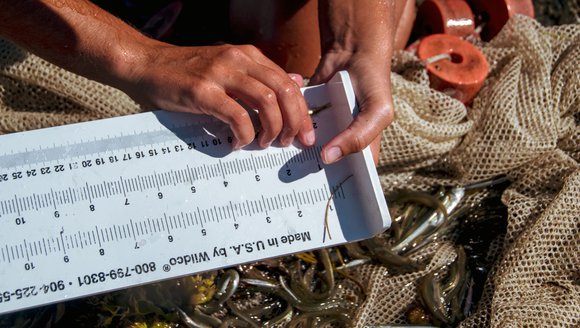Using telemetry and eDNA to quantify marine biodiversity
Characterizing trophic interactions of near-shore communities.
We are using acoustic telemetry, active acoustics, passive acoustics, eDNA, and traditional sampling to track the movements and diets of important predators, Atlantic cod, and common terns in relation to forage fish.
Project Goals:
- Characterize seasonal and interannual changes in Atlantic cod and common tern movements and their diets in two coastal systems.
- Correlate movements and diet of predators with regional marine biodiversity.
- Determine how indicators of biodiversity vary with environmental changes.
- Use bioenergetics modeling to predict potential consequences of changes in water temperature and food availability on energy budgets of Atlantic cod and common terns.
The Coastal New England Biodiversity Observation Network (CNEBON) project is integrating powerful technologies (acoustic telemetry, environmental DNA (eDNA), and acoustics) with fisheries sampling to quantify the importance of estuary mouths to coastal predators and marine biodiversity.
Beyond unveiling important relationships between predators, prey, marine biodiversity, and environmental conditions, we will determine the scales at which varying perspectives of marine biodiversity correlate. Within the rapidly warming Gulf of Maine, we will focus on estuarine-coastal systems: the Isles of Shoals near Great Bay, New Hampshire, and Casco Bay, Maine where permanent acoustic telemetry infrastructure is lacking.



Via telemetry we will track the movements and diet of important predators, Atlantic cod and common terns, to determine their reliance on forage species. Using eDNA, active acoustics, passive acoustics, and traditional sampling, we will track marine biodiversity and the presence of forage species, including herrings. We will integrate biodiversity data with environmental observing via publicly available data through NERACOOS, among others.
Comparing and contrasting species’ responses to environmental change will both provide biotic indicators of ecological dynamics and help predict the “winners and losers” of climate change.


GMRI Project Team:
Read More
-
![Gulf of Maine, Explained: Fisheries Acoustics]()
Gulf of Maine, Explained: Fisheries Acoustics
In the vast depths of the Gulf of Maine, concentrated patches of organisms punctuate long empty stretches. This can create some challenges for scientists who …
Gulf of Maine, Explained
-
![2022 Research Progress Update]()
2022 Research Progress Update
To keep you updated on our research team's progress, we've developed a report showcasing some of the achievements from our labs. More broadly, this report …
Announcements
-
![Gulf of Maine, Explained: Causes & Impacts of Rapid Warming]()
Gulf of Maine, Explained: Causes & Impacts of Rapid Warming
In this Gulf of Maine, Explained video, GMRI Climate Center Director Dr. Dave Reidmiller explains why the Gulf of Maine is warming faster than most …
Gulf of Maine, Explained
-
![A Field Season in Photos]()
A Field Season in Photos
Explore our 2022 Field Season with a selection of our favorite photos from throughout the year. Whether tagging blue sharks offshore, seining the beaches of …
Perspectives






